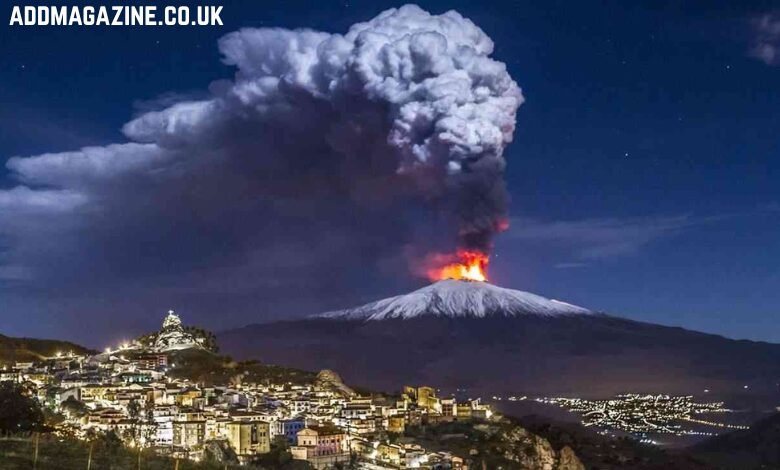When you think of volcanoes, many people imagine dangerous eruptions or smoke rising from the earth. One of the most famous and active volcanoes in the world is Mount Etna in Sicily, Italy. Locals call it Mongibello, a name that comes from the Arabic word “Jebel,” meaning mountain. Mount Etna is not just a natural wonder, but also a symbol of the island’s rich culture, history, and beauty. This giant mountain, standing tall in the eastern part of Sicily, is a must-see for anyone visiting the island.
What is Mount Etna?
Mount Etna is one of the world’s most active volcanoes. It is a stratovolcano, which means it’s made up of layers of lava and ash from many years of eruptions. What makes Etna unique is its regular eruptions, which happen several times a year. But don’t be alarmed—despite being active, the eruptions are usually not dangerous to people living nearby, thanks to careful monitoring and warning systems in place.
Standing at 3,329 meters (10,922 feet), Mount Etna is one of the tallest volcanoes in Europe. Its size and power have made it a fascinating subject for scientists, tourists, and even artists throughout history. The mountain is located near Catania, a bustling city on the eastern coast of Sicily, making it a perfect destination for those exploring the island.
The History and Importance of Mount Etna
Mount Etna has been actively erupting for millennia, shaping the landscape with its continuous volcanic activity. Its first known eruption dates back to around 1500 BC, and it hasn’t stopped since. The volcano is part of a system of faults and cracks in the earth’s crust, which allows magma (or molten rock) from deep below the earth’s surface to rise and break through the ground.
Ancient civilizations such as the Greeks and Romans paid close attention to Mount Etna. They believed the volcano was home to gods and mythical creatures. For the Greeks, the god Hephaestus (the god of fire) was said to live inside the volcano. The Romans also had their myths about the volcano, believing it was the forge of the mighty god Vulcan.
Today, Mount Etna is not just a natural wonder but also a UNESCO World Heritage Site. This means it is recognized for its importance to the world. People come from all over the globe to study and admire this magnificent volcano, which continues to shape the land and lives of those around it.
How Mount Etna Erupts
Eruptions at Mount Etna can vary in size and intensity. Some eruptions are small and cause little damage, while others can be more powerful, sending ash and lava into the sky. What makes Etna special is that it often has frequent, but relatively gentle eruptions. Most of the lava flows down the sides of the mountain in slow-moving streams, which allows people to avoid danger.
When Mount Etna erupts, the sky can turn dark with volcanic ash. The air becomes thick, and the ground shakes as the volcano releases its power. However, the surrounding towns and villages are prepared for such events, with people knowing how to stay safe when the volcano shows signs of activity. Scientists and volcanologists closely monitor Etna’s eruptions to provide early warnings, so people can take precautions when necessary.
The eruptions also help to create fertile soil around Mount Etna, which is excellent for farming. The ash and minerals that fall on the land provide nutrients to crops, making the region an important agricultural area. The lush landscape around the volcano is filled with vineyards, citrus groves, and olive trees.
Life Around Mount Etna
People who live near Mount Etna have learned to live with the volcano. Despite its activity, the volcano has brought prosperity to the region. Many towns and villages around Etna are home to farms that grow some of Italy’s finest produce. The fertile soil is perfect for growing fruits, vegetables, and especially grapes for wine. Some of the best wines in Italy come from the slopes of Etna, where the volcanic soil adds unique flavors to the grapes.
The volcano also attracts many tourists each year. People come to hike its slopes, visit the craters, and experience the breathtaking views. In winter, Mount Etna is covered in snow, creating a beautiful contrast with its dark volcanic rocks. Tourists can ski on the slopes of Etna during this time, while others come to enjoy the warm, sunny weather in the spring and summer.
Mount Etna’s Impact on Science
Mount Etna is not just a beautiful sight; it is also an important site for scientific research. Geologists and volcanologists come from all over the world to study the volcano. By understanding how Etna erupts and behaves, scientists can learn more about volcanoes in general and how to predict eruptions. The constant activity at Mount Etna provides a unique opportunity to study the earth’s processes in real time.
The volcano is also important for studying climate change. Scientists are observing how eruptions at Etna can affect the environment. Ash and gases released during eruptions can travel high into the atmosphere, affecting air quality and even changing the weather in some regions.
Mount Etna and the Local Economy
Mount Etna is central to the economy of the surrounding areas. As mentioned, the fertile lands on its slopes are perfect for farming, and the volcano is a source of tourism. Every year, thousands of people visit Mount Etna to experience its beauty, history, and power. This influx of visitors helps the local businesses, hotels, and restaurants thrive.
In addition to farming and tourism, Mount Etna has also provided materials for construction. The volcanic rocks from the mountain have been used for centuries in buildings, roads, and other structures. The local people are proud of the history and resources the volcano has provided.
Safety and Precautions
Although Mount Etna is an active volcano, safety measures are in place to protect those who live near it. As a result of careful monitoring, scientists can predict eruptions with reasonable accuracy. When an eruption is expected, authorities can evacuate people from the most dangerous areas, ensuring that everyone stays safe. Warning systems are in place, and locals are well-prepared for the occasional ash fall or lava flow.
The local government works closely with the people living near the volcano to help them prepare for any emergencies. The area has extensive disaster preparedness programs, including evacuation plans and first aid kits, which are vital when the volcano shows signs of activity.
Fun Facts About Mount Etna
- It’s one of the most active volcanoes in the world, with eruptions occurring regularly.
- Mount Etna’s eruptions are usually gentle, making it safer than other volcanoes.
- The soil around Etna is very fertile, perfect for growing crops, especially grapes.
- It has more than 200 craters spread across its slopes.
- Mount Etna has been erupting for more than 3,000 years—making it one of the oldest active volcanoes.
- In winter, Mount Etna becomes a ski resort, with snow covering its slopes.
Conclusion
Mount Etna, or Mongibello, is much more than just a volcano. It is a vital part of Sicily’s culture, economy, and environment. This mighty mountain continues to shape the land around it, providing fertile soil for farming, spectacular views for tourists, and a wealth of scientific knowledge for researchers. Whether you’re hiking its slopes, enjoying a glass of local wine, or simply admiring the view from a distance, Mount Etna is a reminder of the power and beauty of nature.
So, next time you find yourself in Sicily, don’t miss the chance to visit this incredible natural wonder. The experience of being in the shadow of Mount Etna is something you’ll never forget.
FAQs
1. How often does Mount Etna erupt?
Mount Etna erupts frequently, with smaller eruptions happening several times a year. Some eruptions can be as small as lava flows, while others can be more intense.
2. Is it safe to visit Mount Etna?
Yes, Mount Etna is generally safe to visit. The area is well-monitored by scientists, and safety measures are in place, such as evacuation plans and warning systems.
3. Can you ski on Mount Etna?
Yes, in winter, Mount Etna is covered with snow, and it becomes a popular location for skiing and snowboarding.
4. What is Mount Etna famous for?
Mount Etna is famous for being one of the most active volcanoes in the world and for its fertile soil, which supports agriculture, especially vineyards.
5. Why is Mount Etna important to scientists?
Mount Etna provides valuable data for scientists studying volcanic activity, geology, and even climate change due to its frequent eruptions and constant monitoring.



